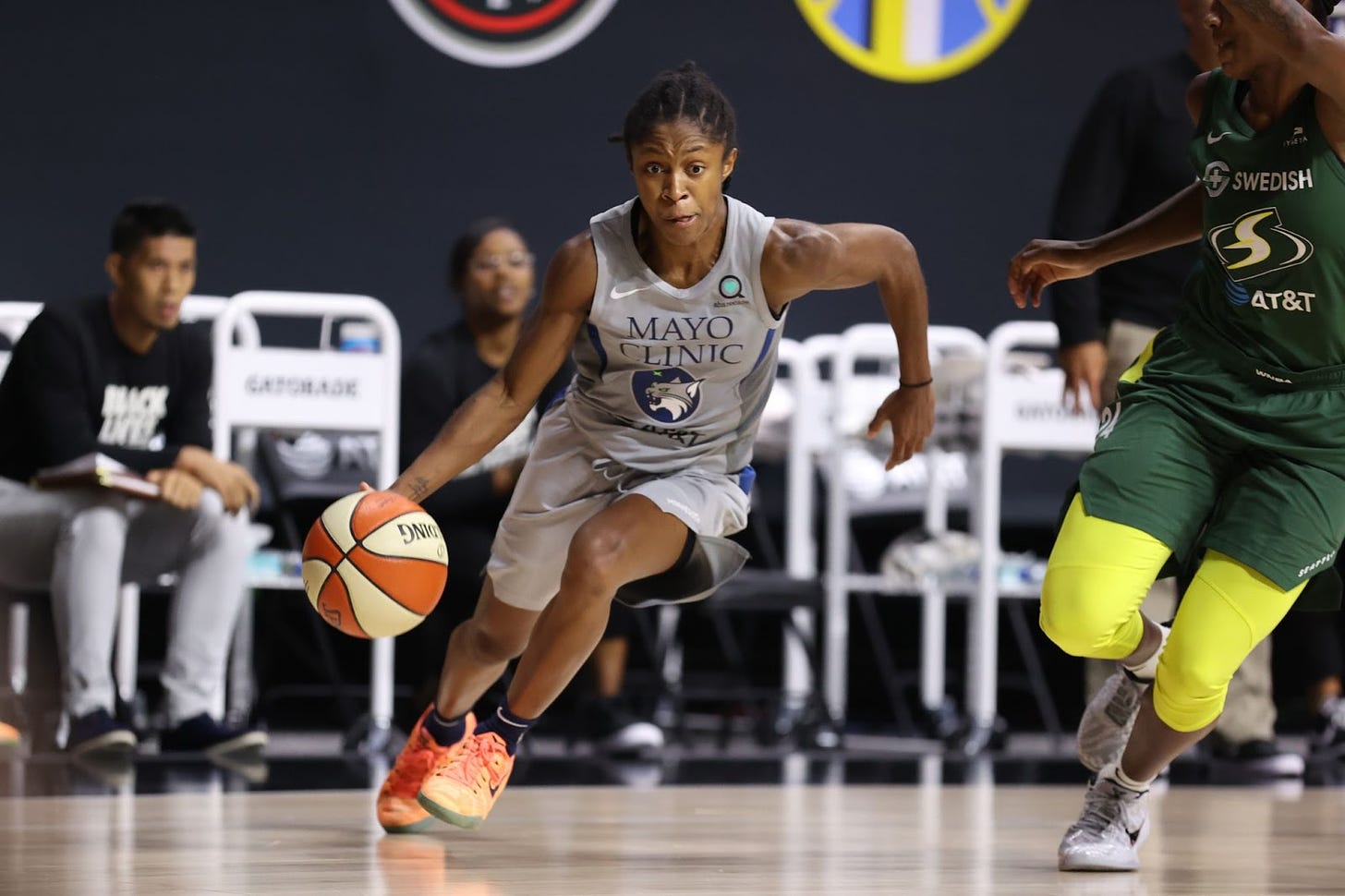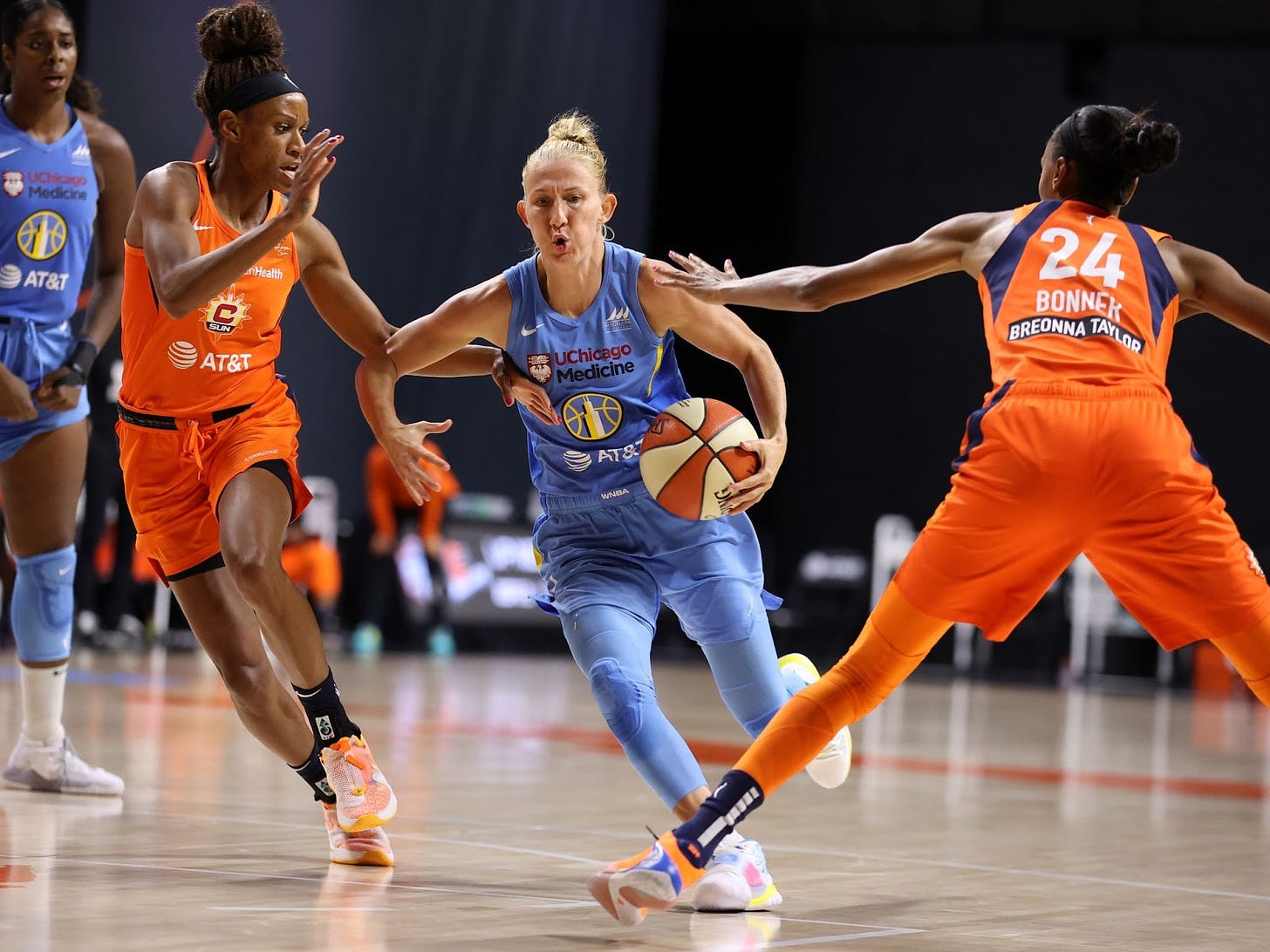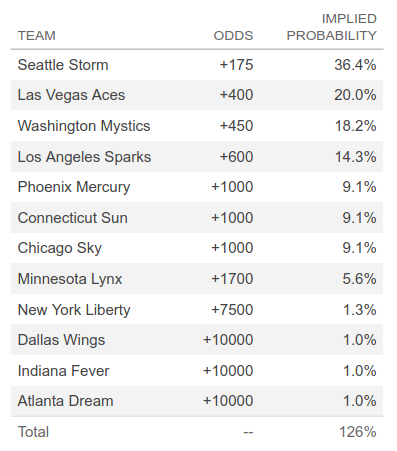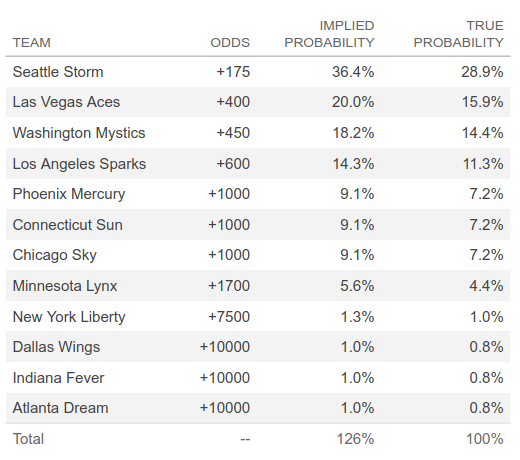WNBA Betting Preview: 2021 Championship Odds
Which teams are the sportsbooks overlooking heading into the season?
Thanks for reading the Her Hoop Stats Newsletter. If you like our work, be sure to check out our stats site, our podcast, and our social media accounts on Twitter, Facebook, and Instagram. You can also buy Her Hoop Stats gear, such as laptop stickers, mugs, and shirts!
Haven’t subscribed to the Her Hoop Stats Newsletter yet?
The 2021 WNBA season is nearly here! Some teams are already playing preseason games, but the games that count will get underway in 9 days. There’s plenty to look forward to this season — in addition to the usual excitement around rookies entering the league and free agents debuting with their new teams, we’ll also get to see teams play at their home arenas for the first time in two years, and several stars who opted out of the 2020 season are set to return.
From social media to fantasy leagues to purchasing gear (this season’s new jerseys have been getting lots of attention!), there are plenty of ways to get involved beyond watching the games. One fun way to get in on the action is to bet on it. And betting can add an extra layer of fun when crunching the numbers, if you’re into that sort of thing. We wouldn’t be called Her Hoop Stats if we didn’t start by diving into the data, but if you’re like most of the world and hate math, then just skip to the break a few paragraphs down.
Once the season kicks off, there will be lots of options for betting each game, which we’ll get into as the year goes on. For now, you can place a futures bet, which is a bet on a certain team to win the championship. Here are FanDuel’s odds for each team as of May 4:
First, let’s break down what the numbers in this graphic mean. A number after a plus sign means that if you bet $100 on that team and they win it all, you’ll win that much money. So a $100 bet on the Storm will pay out $275 (the original $100 bet returned plus the $175 in winnings) if Seattle repeats. (As we get more into single-game betting throughout the season, we’ll explain what minus signs mean, but we don’t have any of those for this year’s futures.) The teams with higher numbers come with greater rewards, but also greater risk — those are the teams that are less likely to win. The Fever aren’t likely to win a title this season, so a $100 bet on Indiana would win you $10,000!
These figures hold proportionally for larger or smaller bets as well. That $100 bet on the Storm that returns $175 in winnings could be reduced to a $1 bet that returns $1.75 in winnings, or that Fever wager could be a $1,000 wager that returns $100,000. A standard way to describe this is by using “units.” Bettors will often say that a 100-unit bet on the Storm returns 175 units. This language makes the odds more accessible for all gamblng budgets, no matter how big or small.
We can use these numbers to calculate the true probability of each team winning the championship (according to the books) as well as something called the “implied probability.” The implied probability is calculated by dividing the bet by the payout (including the return of original bet). For instance, a $100 bet on the Aces at +400 would pay the $100 back as well as $400 in winnings, for a total of $500. We can take 100/500, which gives us an implied probability of 20% for an Aces championship. This is the key decision-making number — this bet is only worth it if you believe the Aces have a better than 20% chance to win the title.
A team’s implied probability is close to the probability that the book thinks it has to win the title, but it’s not exactly the same. You may notice that the third column of the chart above adds up to more than 100 percent (126, specifically). That’s because sportsbooks have to make money, so they charge a tax of sorts called vigorish — commonly known as vig or juice.
Juice applies to all types of bets, but it’s easier to illustrate by taking a look at how it works for a “coin flip” bet (i.e. a bet on a single game where each side has a 50% chance of winning). It depends on several factors (which book, which sport, how soon the game starts…), but the implied probability for each side is generally around 52.5% in these situations. Two implied probabilities of 52.5% add up to 105%, which of course is over 100%. That’s how the books make a profit — the implied probability is how often you have to win that bet to break even, so you can be good enough to win a coin flip bet 52% of the time and still lose money.
It follows, then, that the true probability of each team winning the championship (according to the book’s model) is a little lower than the implied probability. A team’s true probability can be calculated by dividing its implied probability by the total of the implied probabilities (in this case, 126%). So Vegas believes that its hometown Aces have a true championship probability of 15.9% (20/126). The true probabilities have been added to the table below.
This means that you only want to place a bet if you think a team’s chances are significantly higher than the oddsmakers think they are, not just slightly higher. Phoenix and Connecticut, for example, each have a 7.2% chance to win it in the eyes of FanDuel. However, you won’t be expected to come out ahead by betting on either one of them unless you think one of them actually has over a 9.1% chance to win the championship. If you think the Sun have an 8% chance to win the title, stay away; if you think they have a 15% chance, put your money down.
So which teams look like savvy bets this year? Let’s start with the Lynx. Minnesota returns just about everyone from a team that was the fourth-best a year ago by almost any measure. The last two Rookie of the Year winners, Crystal Dangerfield and Napheesa Collier, join elite center Sylvia Fowles, who told the Twin Cities Pioneer Press that her calf is “98 percent healed” following a season in which it caused her to miss several games.
The Lynx also used free agency to solidify a backcourt that was already dangerous from behind the arc. The two most accurate three-point shooting seasons in Lynx franchise history came in 2020 from Rachel Banham (47.2%) and Bridget Carleton (45.7%), who both brokeMaya Moore’s record of 45.3% set in 2013. Over the offseason, Cheryl Reeve added Aerial Powers — a key piece of the Mystics’ 2019 championship team who finished in the top ten in the league in win shares per 40 minutes that year — and three-time All Star Kayla McBride, who finished second in each of the last two three-point contests. Both can score and defend and were two of the more coveted free agents of the offseason.
The frontcourt got a boost as well. After a breakout season from Damiris Dantas, Minnesota signed Natalie Achonwa to help keep Fowles fresh for the long haul. Then forward Rennia Davis, whom Reeve had second on her draft board, fell to the Lynx at the No. 9 pick in last month’s draft. Davis can rebound and guard multiple positions, and Reeve has already proven that she is one of the best at player development. Davis did suffer a foot injury in training camp and is out indefinitely, but there is hope that she can return this season and help the team down the stretch.
Bottom line: A team that was already good added a ton of talent for a coach that has shown that she can win without it. It’s a scary prospect for the rest of the league, and it’s why the Lynx are in the mix among the championship contenders. It seems like the healthy floor for this squad is another fourth-place finish. Getting Minnesota at the eighth-best odds feels borderline criminal.

Another team the books seem to be undervaluing is the Sky, whose odds are tied for the fifth-best with the Sun and the Mercury. Chicago was thought by many to be in the running for a title early on last season — even reaching the top spot in our power rankings at one point — before injuries to Azurá Stevens and Diamond DeShields led to a late-season slide. Both will be back, albeit with a minutes restriction in Stevens’ case. They’ll join sharpshooter Allie Quigley and her “point god” wife, Courtney Vandersloot, who in 2020 became the first player in WNBA history to average 10 assists per game.
Chicago’s biggest splash of the offseason came in the form of arguably the most prominent free agent signing the league has ever seen when Candace Parker agreed to a deal to return to her hometown. The other C. Parker — Cheyenne — left for Atlanta, but Candace should more than replace her production.
The pick-and-roll combination of Vandersloot and Parker should be deadly, but Parker’s most needed impact might be on the defensive end. Chicago has finished in the bottom half of the league in defensive rating five years running, and with versatile defender Gabby Williams’ future with the team seemingly up in the air, it will be crucial for James Wade to improve his defense. Adding the reigning Defensive Player of the Year isn’t a bad place to start.
Wade may have addressed his team’s other 2020 bugaboo this offseason as well. No player in the league positively influenced their team’s performance more by being on the court last year than Vandersloot — the Sky’s net rating dropped a full 28 points per 100 possessions with her on the bench, from 9.3 all the way to -18.7. For comparison, the Aces had the second-best net rating last season at 10.0 while the Liberty had the lowest at -17.2. In other words, Vandersloot’s presence on the floor was the difference between the Sky functionally performing at Las Vegas level or at New York level.

Wade used his No. 8 draft pick on Shyla Heal, an Australian point guard who should immediately step into the backup role and stabilize the offense when Vandersloot sits. Between Heal, Parker, and the (hopeful) health of Stevens and DeShields, the Sky are primed to compete at the top of the standings. Their odds aren’t as favorable as the Lynx, but at +1000, they are still a solid bet.
Gambling, of course, is a personal decision that shouldn’t be taken lightly. It can cause great financial stress if done irresponsibly. If you do bet on the WNBA, remember to only wager money that you would be comfortable losing. Unless you’re a seasoned professional bettor with a proven strategy, it’s probably best to think of it as an entertainment cost. When you pay to see a movie, you do so knowing that you aren’t getting that money back. It’s cash you are willing to part with in exchange for the fun of the movie experience. Yes, the goal of betting is to make a profit, but if you mentally prepare for the worst outcome, then the best will be that much sweeter. So analyze your budget and decide whether sports betting is for you. If it is, then go slap some dollars on the Lynx or the Sky!
Thanks for reading the Her Hoop Stats Newsletter. If you like our work, be sure to check out our stats site, our podcast, and our social media accounts on Twitter, Facebook, and Instagram. You can also buy Her Hoop Stats gear, such as laptop stickers, mugs, and shirts!
Haven’t subscribed to the Her Hoop Stats Newsletter yet?






